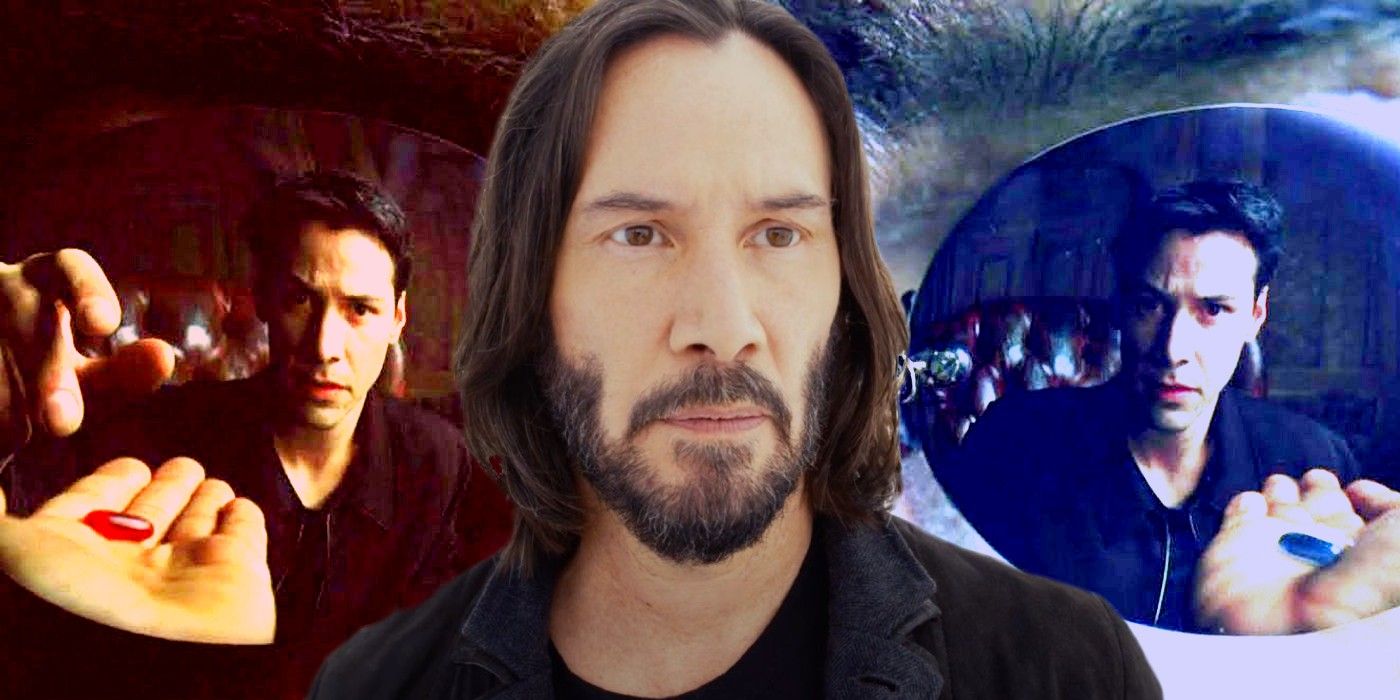The red pill or blue pill is Neo’s biggest choice in The Matrix… but was it really a choice at all? After almost 20 years turning down a fourth movie, Lana Wachowski’s The Matrix Resurrections finally released in December 2021. Far from a conventional sequel, The Matrix Resurrections revisits the original 1999 movie from a fresh perspective, questioning Zion’s us-or-them philosophy, introducing a more nuanced Matrix simulation, and re-framing the entire concept of The One. The most important way The Matrix Resurrections alters the first film’s perspective, however, is by proving Neo’s “choice” was always a lie.
The concept of choice is essential to the Wachowskis’ Matrix trilogy. The journey begins with Neo choosing between the red pill (consciousness) and the blue pill (ignorance). In The Matrix Reloaded, the Architect then presents Neo with yet another choice – reboot the Matrix to continue the ongoing cycle of Zion’s destruction, or save Trinity. Finally, The Matrix Revolutions forces Neo to decide between life and death – sacrificing himself for humanity, or living out his remaining years with Trinity. Neo’s choices are fundamental to his character across the first three Matrix movies, and prove his humanity compared to both the synthetic binary Machines, and the brainwashed souls inside the Matrix. Choice is what makes Neo truly conscious… right?
The Matrix Resurrections redefines the meaning of choice, proving the red pill/blue pill, the Architect’s doors, and even Neo’s sacrifice were all just an illusion of choice. When Jessica Henwick’s Bugs offers Yahya Abdul-Mateen’s Morpheus/Smith hybrid his own two colored pills, she admits the scenario is entirely symbolic, claiming, “The woman with the pills laughed because I was missing the point… the choice is an illusion. You already know what you have to do.” This thematic thread runs throughout the entirety of The Matrix Resurrections. When Morpheus rescues Neo from an Io holding cell, he gives him the choice between breaking free or staying put, then adds, “But that ain’t a choice.” During their therapy sessions, the Analyst describes Neo’s struggle between mental breakdown and the Matrix being real as “not much of a choice,” and Bugs’ pilot utters “you call that a choice?“ when told to pick between death by squids and an Io court martial.
The Matrix Resurrections proves The Matrix‘s red and blue pill dilemma was never about choice – it was a blend of coercive inevitability. As Bugs points out, a choice isn’t a choice if the person already knows what decision they must make. Whether picking a pill, selecting a door, or sacrificing his own life, Neo was never making choices in The Matrix because his actions were inevitable. Bugs raises a point about whether humans are as free as they like to believe – digital programming ruled Neo’s mind in the Matrix world, psychological programming determines his path in the real world. Isn’t this why Trinity chose to leave the Matrix, rather than stay with her digital family?
The Matrix Resurrections also paints The Matrix‘s illusion of choice as a coercive tool. Thomas Anderson faces accepting his mental breakdown, or accepting the Machine apocalypse actually happened. Bugs’ crew face getting killed by Machines, or getting punished by their superiors. One option is decidedly worse than the other in both cases, but neither is especially inviting. The same applies to The Matrix‘s red and blue pills, which is essentially a choice between cold, harsh reality, or a comfortable lie. Given the options on the table, these are more threats than choices.
Oddly, it’s the Analyst who sums up this difference best in The Matrix Resurrections. Smith uses “choice and its absence” as an example of nature’s binary form, going on to cite light and dark, ones and zeroes, and himself and Neo. But when Thomas discusses the concept of choice with his Analyst earlier in the movie, Neil Patrick Harris tells him, “Maybe it’s not as binary as that.” A villain he may be, but these wise words highlight how The Matrix‘s philosophy – the red vs. the blue – was never as binary as it seemed. The Matrix Resurrections delights in taking a non-binary outlook, and this is perfectly represented by Io, where Machines and programs have made a choice – a true choice – to join hands with humanity, and Niobe’s people have chosen to accept them in return.
About The Author

